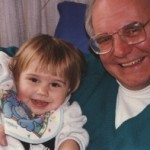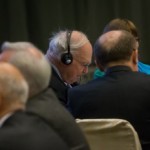Emily’s First Question: What separates the Bible from Grimms’ Fairy Tales?
/
Emily’s First Question
Published by Michael Novak at Patheos.com on January 23, 2015
EMILY: What separates the Bible from a book of moral fables such as Grimms’ Fairy Tales?
GRANDPA: The Bible confronts you with a choice about your future. It lays a challenge before you: to accept God as God, or not; and to accept His offer of friendship with Him, or not.
The wonderful books of fairy tales and folk tales in many different languages amuse you, frighten you, delight you – but they do not give you such an abrupt challenge, and do not call you to change your life at a radical level.
One thing someone pointed out to me, and then I learned to see for myself, is that every book in the Bible, especially in the Jewish Testament, hinges on a free choice. Adam and Eve, Cain and Abel, Abraham with Isaac, King David – all were faced with choices to make. In one chapter, King David is faithful to his Lord, and in another, he betrays his Lord. Thus the overwhelming questions we learn to face are: What will I do next? How do I intend to change my life, or to go on living in the same path?
We wouldn’t know unless God had revealed it, that the Creator is essentially a force for good, even for love, not a malicious Creator or an absurdist. The Jewish Testament does not reveal everything all at once. It limns characteristics of the Creator little by little, and it also sometimes makes a sketch and then does it over, altering it. To do this, the Bible uses many literary genres, many tones of voice, many points of view. Some stories are told a little ironically, almost playfully. Some have a seriousness that clearly intends to say: “This is the literal truth. Pay attention.” One hears this tone of voice in the Ten Commandments, for example, and in many other places.
The essential point of the Jewish Testament, in my view, is that the Creator of all things – that immense power revealed in terrifyingly tempestuous seas, the crack of thunder, and blinding flashes of light, the sort that teach us how helpless we are out on the high seas in the middle of a storm, sheltered only by the wooden sides of a boat – is not hostile to us. On the contrary, He invites us to be His friends, even to live in Him and He in us.
Sometimes too, we see all around us only meaninglessness. We call on God, but there is only silence, only emptiness, only dark and dry desert air. We can find testimony to this experience even in the most celebrated of believers, such as Mother Teresa, St. Thérèse of Lisieux, St. John of the Cross. Whole books have been written to guide us through the dark nights in which God allows us to experience abandonment and pointlessness.
Given the range of experiences it gives us, human life of itself is not altogether clear about whether God is hostile to us or friendly to us.
The Bible from start to end makes two loud and clear points: in it, the Creator warns that we will be much besieged, left alone in a desert, buffeted, without any sense of meaning or solace or comfort. Even God’s son, Jesus, was reduced to saying as He hung upon the Cross: “My God! My God! Why hast Thou forsaken me?” On the other hand, and at the same time, the Bible tells us that the Lord, despite all these bitter trials, gathers us under His arm as a hen gathers its chicks, and that He extends His love to us. His is not always a sweet love, but sometimes a trying and testing love.
Maybe some people want a God who is always sweet, always giving comfort, always giving consolation. That is not the God described in the Bible, either in the Jewish Testament or in the Christian Testament. Consider the story of Job. Consider the story of Jesus – or, for that matter, of the eleven Apostles who met horrific deaths. (Tradition holds that St. John the Evangelist alone died a natural death, at Ephesus, which we visited with Nana just weeks before her death.)
If you are seeking only sweetness, you ought not to come to Judaism or Christianity. “Those He loves, He makes to suffer.”
Reading these texts slowly and often, meditating on them, one is driven to conclude that the Jewish God and the Christian God – without question, they are related – is a tough God, raising up a tough people. But the overwhelming evidence of existence is that He conceived of this universe and created it out of love, out of goodness, out of outward-going generosity, even in the face of our own betrayals, turnings away, sin, and sometimes malice. The Bible rams this point home more concretely and more deeply than Plato in his Symposium and Aristotle in book 12 of his Metaphysics.
God does not want in return the friendship of slaves; He wants the friendship of free women and free men. As the much-loved French poet Charles Péguy puts it:
When you once have known what it is to be loved freely, Submission no longer has any taste. All the prostrations in the world Are not worth the beautiful upright attitude of a free man as he kneels. All the submission, all the dejections in the world Are not equal in value to the soaring up point, The beautiful straight soaring up of one single invocation From a love that is free.[1]
EMILY: Admittedly I find this answer somewhat unsatisfactory since the hinge of your explanation is that the Bible asks a person to face moral choices and free will; yet nearly every coming-of-age story could be said to do the same thing, just in a more structured narrative. In fact, after your explanation I am MORE inclined to read the Bible much in the same way I would read Alice in Wonderland.
The original story places Alice through a series of events and challenges that are really only connected by her progress through Wonderland, and during her journey she is constantly learning lessons of deep-thinking and morality, while being challenged and required to act and react along the way. While the figure of Jesus is that of a teacher, Alice is a student of the world, and yet I find myself learning many of the same moral lessons from Alice as I do through Jesus while reading the Bible. Jesus simply lacked the Cheshire Cat.
I say this not as a critical judgment of the Bible, but more for clarification.
Why is the Bible treated so differently from other books of moral fables, especially given that there are many “kid-friendly” versions of the Bible and picture-book-style renditions of the stories within the Bible that can often be indistinguishable from other children’s books?
GRANDPA: I must think about this, and in the next installment of “Emily’s Questions” offer a reply.



